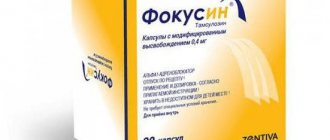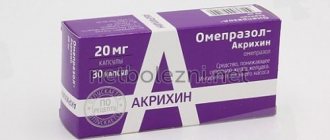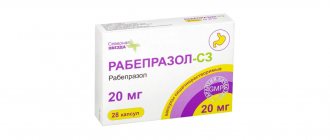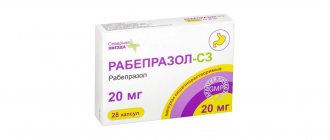Rabeprazole-SZ, 10 mg, enteric capsules, 14 pcs.
Inside.
Rabeprazole-SZ capsules should be swallowed whole. It has been established that neither time of day nor food intake affects the activity of rabeprazole.
For gastric ulcers in the acute stage and anastomotic ulcers
It is recommended to take 10 or 20 mg orally once a day. Typically, cure occurs after 6 weeks of therapy, but in some cases the duration of treatment can be increased by another 6 weeks.
With duodenal ulcer in the acute stage
It is recommended to take 20 mg orally once a day. In some cases, a therapeutic effect occurs when taking 10 mg once a day. The duration of treatment is from 2 to 4 weeks. If necessary, the duration of treatment can be increased by another 4 weeks.
In the treatment of erosive GERD or reflux esophagitis
It is recommended to take 10 or 20 mg orally once a day. The duration of treatment is from 4 to 8 weeks. If necessary, the duration of treatment can be increased by another 8 weeks.
During maintenance therapy for GERD
It is recommended to take 10 or 20 mg orally once a day. The duration of treatment depends on the patient's condition.
For non-erosive gastroesophageal reflux disease without esophagitis
It is recommended to take 10 or 20 mg orally once a day.
If symptoms do not disappear after 4 weeks of treatment, the patient should be further examined. After relief of symptoms, to prevent their subsequent occurrence, the drug should be taken orally at a dose of 10 mg 1 time per day as required.
For the treatment of Zollinger-Ellison syndrome and other conditions characterized by pathological hypersecretion,
the dose is selected individually. The initial dose is 60 mg per day, then the dose is increased and the drug is prescribed at a dose of up to 100 mg per day in a single dose or 60 mg 2 times a day. For some patients, fractional dosing of the drug is preferable. Treatment should be continued as clinically necessary. In some patients with Zollinger-Ellison syndrome, the duration of treatment with rabeprazole was up to one year.
For eradication of Helicobacter pylori
It is recommended to take 20 mg orally 2 times a day according to a specific regimen with appropriate combinations of antibiotics. The duration of treatment is 7 days.
Patients with renal and liver failure.
No dose adjustment is required for patients with renal failure.
In patients with mild to moderate hepatic impairment, blood concentrations of rabeprazole are usually higher than in healthy volunteers. When prescribing Rabeprazole-SZ to patients with severe liver failure, caution should be exercised.
Elderly patients.
No dose adjustment is required.
Children.
The safety and effectiveness of rabeprazole 20 mg for the short-term (up to 8 weeks) treatment of GERD in children aged 12 years and over is confirmed by extrapolation of the results of adequate and well-controlled studies confirming the effectiveness of rabeprazole in adults and safety and pharmacokinetic studies in pediatric patients.
The recommended dose for children aged 12 years and over is 20 mg once a day for up to 8 weeks.
The safety and effectiveness of rabeprazole for the treatment of GERD in children younger than 12 years of age have not been established. The safety and effectiveness of rabeprazole for other indications has not been established in pediatric patients.
Rabeprazole, 20 mg, enteric tablets, 14 pcs.
Before and after treatment, endoscopic monitoring is required to exclude malignant neoplasms, because Treatment may mask symptoms and delay correct diagnosis.
Rabeprazole tablets should not be chewed or crushed. The tablets should be swallowed whole. It has been established that neither time of day nor food intake affects the activity of rabeprazole.
In a special study in patients with mild or moderate hepatic impairment, the incidence of side effects of rabeprazole was not found to be significantly different from that in age- and sex-matched healthy individuals, but despite this, caution is recommended when first prescribing the drug to patients with severe impairment. liver.
For patients with impaired renal or hepatic function, dosage adjustment of rabeprazole is not required. The AUC of rabeprazole sodium in patients with severe hepatic impairment is approximately two times higher than in healthy patients.
Hypomagnesemia
Rare cases of symptomatic or asymptomatic hypomagnesemia have been reported when treated with PPIs for at least 3 months. In most cases, these reports were received one year after therapy. Serious adverse events included tetany, arrhythmia, and seizures. Most patients required treatment for hypomagnesemia, including magnesium replacement and PPI discontinuation. In patients who will be receiving long-term treatment or who are taking PPIs with drugs such as digoxin or drugs that can cause hypomagnesemia (eg, diuretics), health care providers should monitor magnesium concentrations before initiating PPI treatment and during treatment.
Patients should not take other acid-reducing agents, such as H2-histamine blockers or proton pump inhibitors, at the same time as rabeprazole.
Bone fractures
PPI therapy may increase the risk of osteoporosis-related fractures of the hip, wrist, or spine. The risk of fractures is increased in patients receiving high doses of PPIs for a long time (a year or more).
Concomitant use of rabeprazole with methotrexate
According to the literature, simultaneous use of PPIs with methotrexate (primarily in high doses) can lead to increased concentrations of methotrexate and/or its metabolite hydroxymethotrexate and increase the half-life. which can lead to methotrexate toxicity. If high doses of methotrexate are required, temporary discontinuation of PPI therapy may be considered.
Infections caused by Salmonella, Campylobacter and Clostridium difficile
PPI therapy may lead to an increased risk of gastrointestinal infections, such as those caused by Salmonella, Campylobacter, and Clostridium difficile.
Impact on the ability to drive vehicles and operate machinery
Based on the pharmacodynamics of rabeprazole and its profile of undesirable effects, it is unlikely that rabeprazole affects the ability to drive vehicles and machinery. However, if drowsiness occurs, these activities should be avoided.
Rabeprazol-SZ
Rabeprazole-SZ capsules should be swallowed whole. It has been established that neither time of day nor food intake affects the activity of rabeprazole.
For gastric ulcers in the acute stage and anastomotic ulcers, it is recommended to take 10 mg or 20 mg orally once a day. Usually cure occurs after 6 weeks of therapy, but in some cases the duration of treatment can be increased by another 6 weeks.
For duodenal ulcers in the acute stage, it is recommended to take 20 mg orally once a day. In some cases, a therapeutic effect occurs when taking 10 mg once a day. The duration of treatment is from 2 to 4 weeks. If necessary, the duration of treatment can be increased by another 4 weeks.
When treating erosive gastroesophageal reflux disease (GERD) or reflux esophagitis, it is recommended to take 10 mg or 20 mg orally once a day. The duration of treatment is from 4 to 8 weeks. If necessary, the duration of treatment can be increased by another 8 weeks.
For maintenance therapy of gastroesophageal reflux disease (GERD), it is recommended to take 10 mg or 20 mg orally once a day. The duration of treatment depends on the patient's condition.
For non-erosive gastroesophageal reflux disease (NERD) without esophagitis, it is recommended to take 10 mg or 20 mg orally once a day.
If symptoms do not disappear after four weeks of treatment, the patient should be further examined. After relief of symptoms, to prevent their subsequent occurrence, the drug should be taken orally at a dose of 10 mg once a day as required.
For the treatment of Zollinger-Ellison syndrome and other conditions characterized by pathological hypersecretion, the dose is selected individually. The initial dose is 60 mg per day, then the dose is increased and the drug is prescribed at a dose of up to 100 mg per day with a single dose or 60 mg twice a day. For some patients, fractional dosing of the drug is preferable. Treatment should be continued as clinically necessary. In some patients with Zollinger-Ellison syndrome, the duration of treatment with rabeprazole was up to one year.
To eradicate Helicobacter pylori, it is recommended to take 20 mg orally 2 times a day according to a specific regimen with appropriate combinations of antibiotics. The duration of treatment is 7 days.
Patients with renal and liver failure
No dose adjustment is required for patients with renal failure.
In patients with mild to moderate hepatic impairment, blood concentrations of rabeprazole are usually higher than in healthy volunteers.
When prescribing Rabeprazole-SZ to patients with severe liver failure, caution should be exercised.
Elderly patients
No dose adjustment is required.
Children
The safety and effectiveness of rabeprazole 20 mg for the short-term (up to 8 weeks) treatment of GERD in children 12 years of age and older is supported by extrapolation from adequate and well-controlled studies supporting the effectiveness of rabeprazole in adults and safety and pharmacokinetic studies in pediatric patients. The recommended dose for children aged 12 years and over is 20 mg once daily for up to 8 weeks.
The safety and effectiveness of rabeprazole for the treatment of GERD in children younger than 12 years of age have not been established. The safety and effectiveness of rabeprazole for other indications has not been established in pediatric patients.
Rabeprazole-SZ 20 mg 28 pcs. enteric capsules in Moscow
Rabeprazole-SZ capsules should be swallowed whole. It has been established that neither time of day nor food intake affects the activity of rabeprazole. For gastric ulcers in the acute stage and anastomotic ulcers, it is recommended to take 10 mg or 20 mg orally once a day. Usually cure occurs after 6 weeks of therapy, but in some cases the duration of treatment can be increased by another 6 weeks.
For duodenal ulcers in the acute stage, it is recommended to take 20 mg orally once a day. In some cases, a therapeutic effect occurs when taking 10 mg once a day. The duration of treatment is from 2 to 4 weeks. If necessary, the duration of treatment can be increased by another 4 weeks.
When treating erosive gastroesophageal reflux disease (GERD) or reflux esophagitis, it is recommended to take 10 mg or 20 mg orally once a day. The duration of treatment is from 4 to 8 weeks. If necessary, the duration of treatment can be increased by another 8 weeks.
For maintenance therapy of gastroesophageal reflux disease (GERD), it is recommended to take 10 mg or 20 mg orally once a day. The duration of treatment depends on the patient's condition.
For non-erosive gastroesophageal reflux disease (NERD) without esophagitis, it is recommended to take 10 mg or 20 mg orally once a day
If symptoms do not disappear after four weeks of treatment, the patient should be further examined. After relief of symptoms, to prevent their subsequent occurrence, the drug should be taken orally at a dose of 10 mg once a day as required.
For the treatment of Zollingeo-Ellison syndrome and other conditions characterized by pathological hypersecretion. the dose is selected individually. The initial dose is 60 mg per day, then the dose is increased and the drug is prescribed at a dose of up to 100 mg per day with a single dose or 60 mg twice a day. For some patients, fractional dosing of the drug is preferable. Treatment should be continued as clinically necessary. In some patients with Zollinger-Ellison syndrome, the duration of treatment with rabeprazole was up to one year.
For Helicobacter pylori
It is recommended to take 20 mg orally 2 times a day according to a specific regimen with appropriate combinations of antibiotics. The duration of treatment is 7 days.
Patients with renal and hepatic insufficiency No dose adjustment is required for patients with renal insufficiency. In patients with mild to moderate hepatic impairment, blood concentrations of rabeprazole are usually higher than in healthy volunteers. When prescribing Rabeprazole-SZ to patients with severe liver failure, caution should be exercised. Elderly patients No dose adjustment is required.
Children
The safety and effectiveness of rabeprazole 20 mg for the short-term (up to 8 weeks) treatment of GERD in children 12 years of age and older is supported by extrapolation from adequate and well-controlled studies supporting the effectiveness of rabeprazole in adults and safety and pharmacokinetic studies in pediatric patients. The recommended dose for children aged 12 years and over is 20 mg once daily for up to 8 weeks.
The safety and effectiveness of rabeprazole for the treatment of GERD in children younger than 12 years of age have not been established. The safety and effectiveness of rabeprazole for other indications has not been established in pediatric patients.




